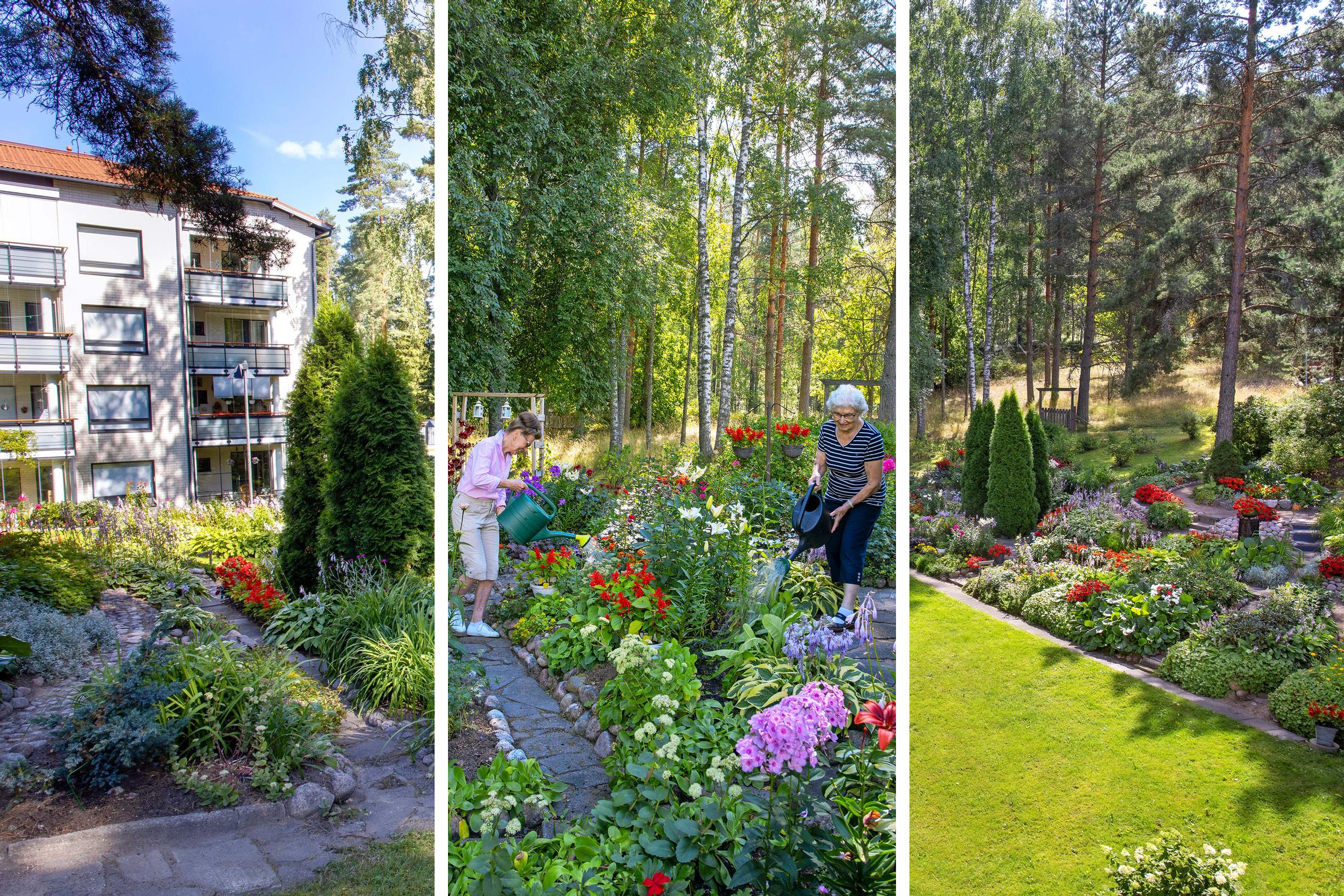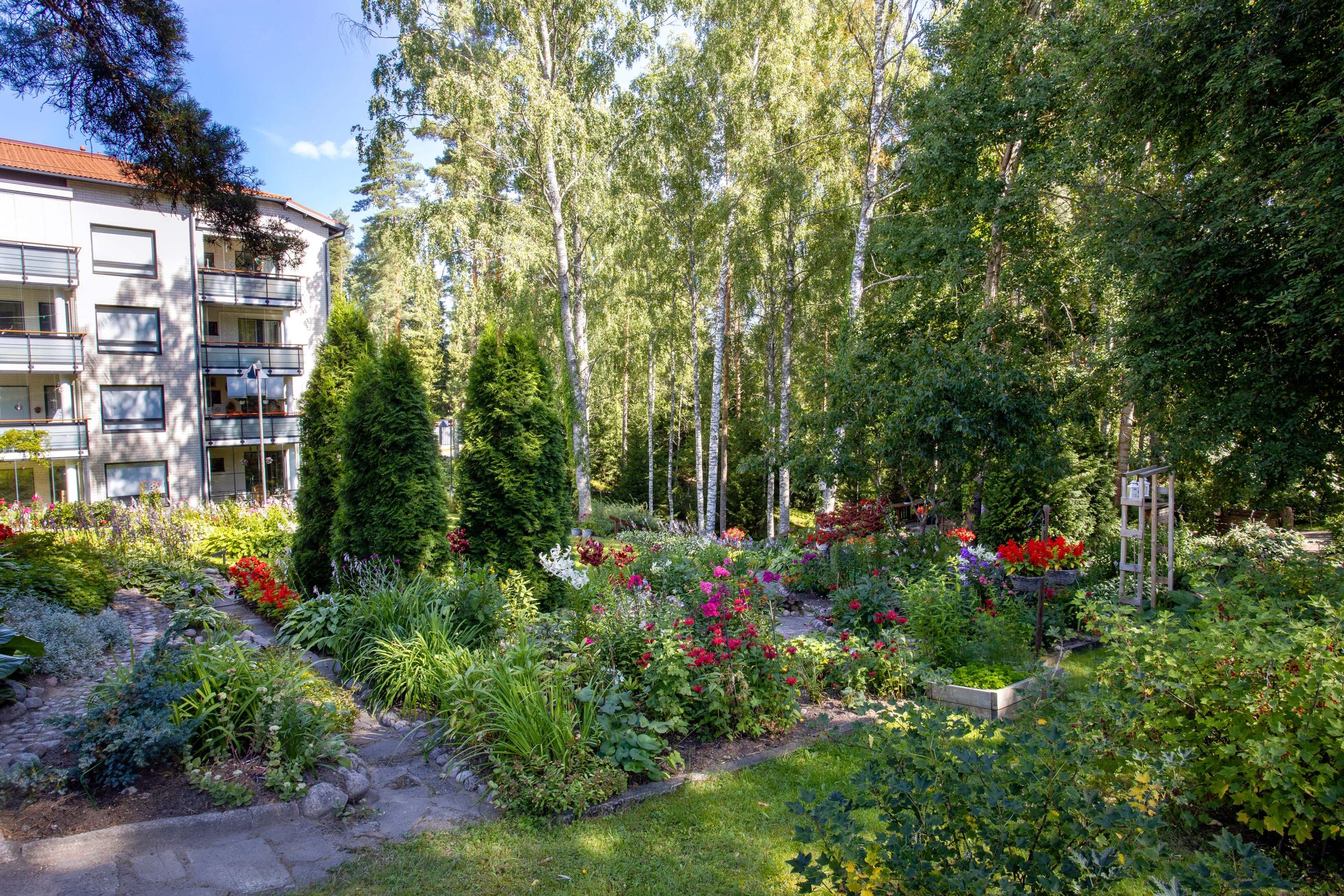
Three resolute women turned their dreary apartment plot into an exquisite garden: “This is a bit of a playground for us grannies”
An abundance of plants and winding paths! These hardworking residents transformed an apartment building plot in Valkeala into a garden. The once desolate area now delights everyone in the building with its gorgeous blooms and stunning greenery.
“There is this painting we can see from our window,” Anja Pukero says, gesturing toward the breathtaking landscape that unfolds around her.
The garden of this ordinary apartment building in Valkeala is anything but ordinary. The lush, impeccably maintained flower garden extends from the apartment building grounds into the neighboring woodland. There, meandering paths are bordered by hostas, cranesbills, and other perennials that thrive in partial shade. Virginia creepers climb the tree trunks. Lilies, garden phloxes, and the vibrant red flowers of scarlet sage and impatiens emerge here and there amidst the greenery.
“We favor red flowers because they stand out so well, even in the shade. Small individual plants don’t stand out in a garden this size; they need to be big and impressive. Impatiens are perfect for that purpose,” Sirpa Suvanto explains.



In 2008, Anja, Sirpa, and Pirkko Lind, who all live in the same apartment building, decided to conceal an unsightly storm drain they found in the garden with plants. To do this, Anja transported sacks of bergenias from her former home in Imatra. The project was swiftly completed, and the bergenias grew to hide the eyesore. The trio found working together so enjoyable that they decided to extend the garden to a larger area. After all, the grounds of the recently built apartment building had only a small patch of lawn and a wasteland overgrown with cow parsley and raspberries.
First, the women determined the boundaries of the lot. Anja’s then 9-year-old granddaughter, Aino, helped them by running with a ball of string from one boundary marker to another. Anja, Sirpa, and Pirkko have grown all the annuals—except for the impatiens from the garden center—during the spring at their homes. By late spring, their balconies are filled with seedlings. Sirpa also pre-sprouts the dahlia tubers she winters in her storage.



The small project soon expanded into a full-fledged garden, which has become a beloved summer hobby for the trio. Mornings are reserved for household chores; in the afternoon, it’s time to head out to the garden. First, they have coffee, then they start the day’s work. By five o’clock, their backs tell them it’s time to stop for the day.
The women don’t need to have elaborate meetings to decide what to do each day. They say they are so alike that they can tell what the other means with half a word. In the early years of the gardening project, it wasn’t so easy, and sometimes it was hard to understand which area the other was talking about.
To avoid confusion, the women decided to name all the paths in the garden. A resident living in the same building made them sturdy signs, and Sirpa, who enjoys crafting, burned the names onto them with her pyrography tool.

“This is a bit of a playground for us grannies. It’s fun to tinker and arrange flowers together. Sometimes we need to drop by home and see from the balcony how our plans appear from there. But most of the time is spent cleaning, as the big trees are constantly making a mess. We also regularly check the plants for aphids and slugs and pinch off faded flowers. We’ve also educated ourselves on compost maintenance. The composted plant waste is essential for the plants because the soil on the lot is very sandy,” Anja explains.
There’s always something to do, and the end result is rewarding. Their fitness improves too, as much of the 2,600-square-meter garden is located on a steep slope formed by a natural depression. When needed, the women even scrape moss and seedlings off concrete and asphalt surfaces with a wire brush. However, that’s minor compared to the effort they put into surfacing the paths that structure the garden. Initially, the paths were fine sand, making it hard to walk, especially with heavy wheelbarrows.

The enthusiastic gardeners thought that since the garden is shared by the whole housing company, all residents should be able to move around in it, whether on foot, with a walker, or in a wheelchair. By chance, the bike paths nearby were being resurfaced with new asphalt at the time, and there were piles of old asphalt chunks lying at the site. The women saw potential in them and asked the workers if they could take the pieces for their garden. Once they got permission, they returned to the site with wheelbarrows. Sirpa and Anja recall with laughter how their progress was eagerly watched and commented on from the terrace of a bar along the route.
“We became quite the sight. We hauled heavy loads in wheelbarrows, with one pushing and the other pulling.”
The hard work paid off, as the jointly arranged asphalt pieces fit beautifully on the paths. Later, they even received more recycled asphalt delivered directly to the garden by the asphalt workers.

The housing company has paid for the soil and spring and autumn fertilizers from the beginning; the women only bought the plants. In addition to homegrown and purchased seedlings, they have received a vast number of plant donations from people who have read their story in the local newspaper or stopped to admire the abundance of plants during their walks.
They still occasionally find bundles of plants left in the garden, but it is becoming difficult to find planting spots for new additions.




